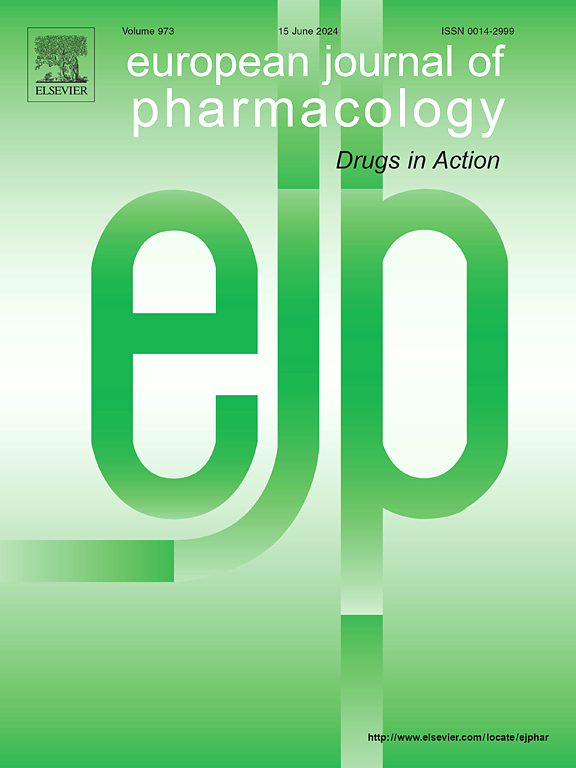抑制SPHK2可通过降低内质网应激减轻慢性间歇性缺氧引起的脂肪组织炎症。
IF 4.2
3区 医学
Q1 PHARMACOLOGY & PHARMACY
引用次数: 0
摘要
阻塞性睡眠呼吸暂停(OSA)以慢性间歇性缺氧(CIH)为特征,是一种普遍存在的疾病,可显著增加心血管和代谢并发症的风险。脂质代谢紊乱是OSA的常见合并症,与cih诱导的脂肪组织炎症密切相关,但其潜在机制尚不明确。在本研究中,我们建立了CIH小鼠模型,研究鞘氨酸激酶2 (SPHK2)和内质网应激(ERS)在CIH诱导的脂质代谢紊乱中的作用。小鼠暴露于正常空气(NA)或CIH中4周或12周。测定血清甘油三酯(TG)、总胆固醇(TC)和低密度脂蛋白胆固醇(LDL-C)以评估全身脂质代谢。CIH组显著升高SPHK2表达,激活附睾(eWAT)和皮下白色脂肪组织(scWAT)中PERK-ATF4-CHOP信号通路,导致NLRP3炎性体积累、氧化应激和脂肪细胞凋亡增加。施用SPHK2抑制剂ABC294640 (opaganib)可减弱这些作用,降低ERS激活并恢复脂质稳态。此外,用ERS抑制剂4-BPA治疗可抑制氧化应激和炎症细胞因子,减轻cih诱导的脂肪组织炎症。相反,由thapsigargin激活的ERS逆转了SPHK2抑制的保护作用,加剧了代谢和炎症失调。总之,我们的研究结果强调了SPHK2和ERS在cih诱导的脂肪组织炎症和脂质代谢紊乱中的关键作用。药理抑制SPHK2是缓解osa相关脂质代谢紊乱的一种有希望的治疗方法。本文章由计算机程序翻译,如有差异,请以英文原文为准。
SPHK2 inhibition alleviates chronic intermittent hypoxia-induced inflammation in adipose tissue by decreasing endoplasmic reticulum stress
Obstructive Sleep Apnea (OSA), characterized by chronic intermittent hypoxia (CIH), is a prevalent disorder that significantly elevates the risk of cardiovascular and metabolic complications. Lipid metabolism disturbances, a common comorbidity in OSA, are closely associated with CIH-induced adipose tissue inflammation, yet the underlying mechanisms remain poorly defined. In this study, we established a CIH mouse model to investigate the roles of Sphingosine Kinase 2 (SPHK2) and endoplasmic reticulum stress (ERS) in CIH-induced lipid metabolic disturbances. Mice were exposed to normal air (NA) or CIH for 4 or 12 weeks. Serum triglycerides (TG), total cholesterol (TC), and low-density lipoprotein cholesterol (LDL-C) were measured to assess systemic lipid metabolism. CIH group significantly elevated SPHK2 expression and activated the PERK-ATF4-CHOP signaling pathway in epididymal (eWAT) and subcutaneous white adipose tissue (scWAT), leading to increased NLRP3 inflammasome accumulation, oxidative stress, and adipocyte apoptosis. Administration of the SPHK2 inhibitor ABC294640, opaganib, attenuated these effects, reducing ERS activation and restoring lipid homeostasis. Further, treatment with the ERS inhibitor 4-BPA suppressed oxidative stress and inflammatory cytokines, alleviating CIH-induced adipose tissue inflammation. In contrast, ERS activation by thapsigargin reversed the protective effects of SPHK2 inhibition, exacerbating metabolic and inflammatory dysregulation. In summary, our findings highlight the critical role of SPHK2 and ERS in CIH-induced adipose tissue inflammation and lipid metabolic disturbances. Pharmacological inhibition of SPHK2 represents a promising therapeutic approach for mitigating OSA-related lipid metabolic disturbances.
求助全文
通过发布文献求助,成功后即可免费获取论文全文。
去求助
来源期刊
CiteScore
9.00
自引率
0.00%
发文量
572
审稿时长
34 days
期刊介绍:
The European Journal of Pharmacology publishes research papers covering all aspects of experimental pharmacology with focus on the mechanism of action of structurally identified compounds affecting biological systems.
The scope includes:
Behavioural pharmacology
Neuropharmacology and analgesia
Cardiovascular pharmacology
Pulmonary, gastrointestinal and urogenital pharmacology
Endocrine pharmacology
Immunopharmacology and inflammation
Molecular and cellular pharmacology
Regenerative pharmacology
Biologicals and biotherapeutics
Translational pharmacology
Nutriceutical pharmacology.

 求助内容:
求助内容: 应助结果提醒方式:
应助结果提醒方式:


